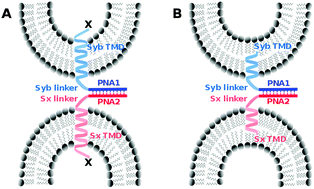Role of the transmembrane domain in SNARE protein mediated membrane fusion: peptide nucleic acid/peptide model systems†
Abstract
Fusion of synaptic vesicles with the presynaptic plasma membrane is mediated by Soluble NSF (N-ethylmaleimide-sensitive factor) Attachment Protein Receptor proteins also known as SNAREs. The backbone of this essential process is the assembly of SNAREs from opposite membranes into tight four helix bundles forcing membranes in close proximity. With model systems resembling SNAREs with reduced complexity we aim to understand how these proteins work at the molecular level. Here, peptide nucleic acids (PNAs) are used as excellent candidates for mimicking the SNARE recognition motif by forming well-characterized duplex structures. Hybridization between complementary PNA strands anchored in liposomes through native transmembrane domains (TMDs) induces the merger of the outer leaflets of the participating vesicles but not of the inner leaflets. A series of PNA/peptide hybrids differing in the length of TMDs and charges at the C-terminal end is presented. Interestingly, mixing of both outer and inner leaflets is seen for TMDs containing an amide in place of the natural carboxylic acid at the C-terminal end. Charged side chains at the C-terminal end of the TMDs are shown to have a negative impact on the mixing of liposomes. The length of the TMDs is vital for fusion as with the use of shortened TMDs, fusion was completely prevented.

- This article is part of the themed collection: Chemical Biology in Molecular BioSystems

 Please wait while we load your content...
Please wait while we load your content...